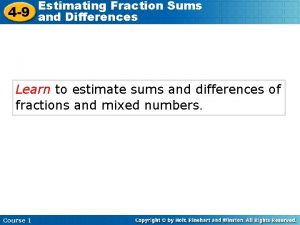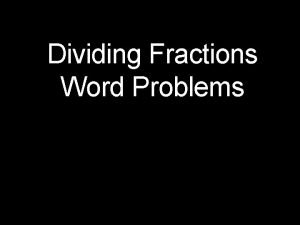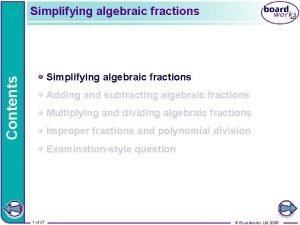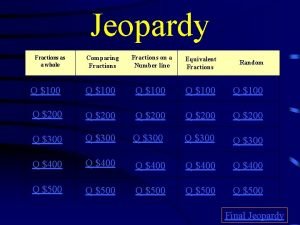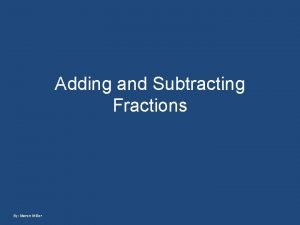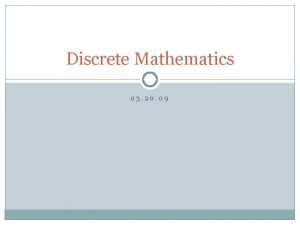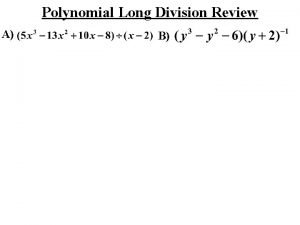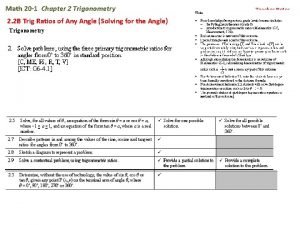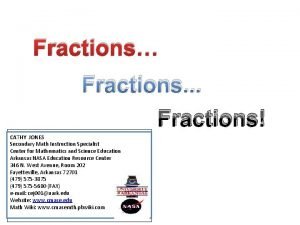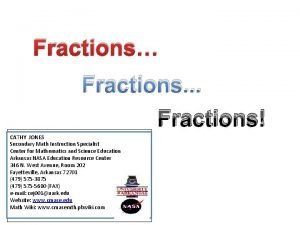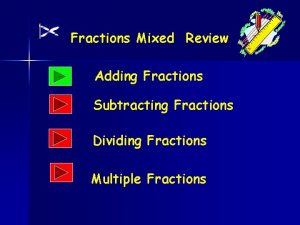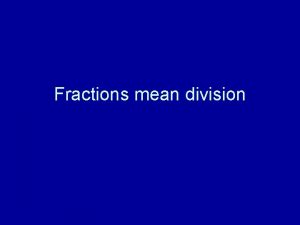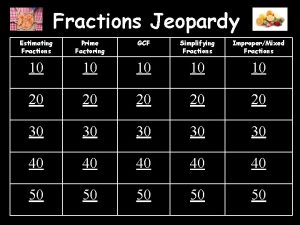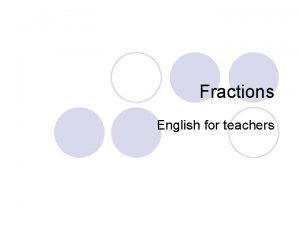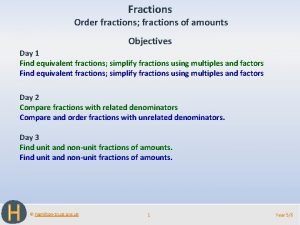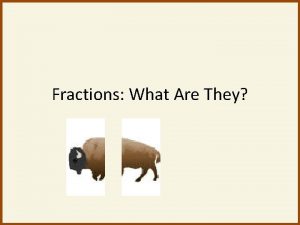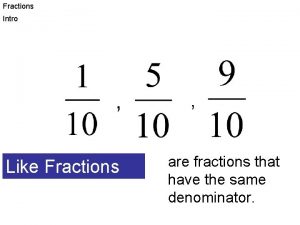Math Test Review Division Fractions Estimating Measuring Dimensions




























- Slides: 28

Math Test Review Division Fractions Estimating & Measuring Dimensions

Division DIVISOR 54 ÷ 6 = 9 DIVIDEND QUOTIENT

Division Does Mc. Donald’s Sell Cheese Burgers? Divide Multiply Subtract Check Bring Down

If the divisor can’t fit into the first digit of the dividend, take the dividend’s first two digits and divide them by the divisor. Multiply to find what you’ve divided so far Subtract to find the extra Check to see if you have anything left to divide. If what’s left after you subtract can’t be divided by the divisor, bring down the next digit from your dividend Repeat these steps until you have divided your entire dividend and you have nothing remaining.

FRACTIONS Numerator # of pieces Fraction Line Denominator Total pieces in the whole

EXPRESSING FRACTIONS USING RATIOS • It represents a comparison between 2 quantities. • Here, the ratio 1: 3 compares the one red apple to the 3 green apples. • There are 3 times more green apples than red ones, or there is one red apple for every 3 green apples.

Equivalent Fractions • They represent the same value in relation to the whole (the same surface) 3/4 and 6/8 are equivalent fractions because 3 x 2 = 6 and 4 x 2 = 8 • To find equivalent fractions, multiply or divide the numerator and denominator by the same number

Reducing Fractions • Making the smallest possible equivalent fraction by finding the greatest common divisor of the numerator and denominator • Divisors of 15: 1, 3, 5, 15 • Divisors of 20: 1, 2, 4, 5, 10, 20

Comparing Fractions • When fractions have the same numerator, compare only the denominators. The smallest fraction has the greatest denominators. • When fractions have the same denominator, compare only the numerators. The greatest fraction has the greatest numerator.

Comparing Fractions • When fractions don’t have the same numerator or denominator, put them over a common denominator. • Find the denominators’ lowest common multiple (LCM). Transform each fraction so the denominators match the LCM.

Adding & Subtracting Fractions • If your fractions have the same denominator, simply add or subtract the numerators • The denominators stay the same.

Adding & Subtracting Fractions with Different Denominators • If you have to add or subtract fractions with different denominators, put them over a common denominator. To do this, find the greatest denominator. 1/3 + 2/9 1/3 – 2/9 1. Check whether the greatest denominator (9) is a multiple of the other denominator. If it isn’t, find the LCM. 2. Convert the fraction (1/3) into an equivalent fraction with 9 as the denominator. 9 becomes the common denominator. 3. Add/subtract your fractions!

Multiplying Fractions by a Natural Number • Multiply the numerator by the integer (or natural number) • The denominator stays the same • If your numerator is bigger than your denominator, your fraction represents more than 1 whole • Reduce a fraction to its simplest form whenever possible

Estimating and Measuring Dimensions Unit km hm dam m dm cm mm Equiv. 1 10 100 1 000 100 000 1 000 • To move up or down the conversion table, multiply by 10 (move the decimal to the right) or divide by 10 (move the decimal to the left) • Each unit of measure is 10 times greater than the unit to its right • Each unit of measure is 10 times smaller than the unit to its left

Division 1. 75 ÷ 3 2. 505 ÷ 10

Equivalent Fractions Find 3 equivalent fractions for the following: 3. 1/4 4. 3/10 5. 1/2

Reducing Fractions Reduce the following fractions to their simplest form: 6. 6/9 7. 11/33 8. 10/12

Multiplying Fractions 9. 6/10 x 4 10. 1/3 x 2

Adding & Subtracting Fractions 11. 1/4 + 2/4 12. 8/10 – 3/5

Ordering Fractions Place the following in increasing order: 13. 1/10, 6/10, 3/10, 9/10, 7/10 14. 1/6, 6/12, 5/6, 11/12, 2/3

Estimating & Measuring Convert the following: 15. 10 km = _____ mm 16. 609 cm = _____ m 17. 60 m = _____ km

Division 18. 522 ÷ 3 19. 106 ÷ 4

Equivalent Fractions Find 3 equivalent fractions for each: 20. 12/18 21. 10/50 22. 6/8

Reducing Fractions Reduce the following to simplest form: 23. 7/14 24. 8/10 25. 2/6

Multiplying Fractions 26. 4/5 x 3 27. 2/10 x 5 28. 10/30 x 4 29. 3/5 x 2

Adding & Subtracting Fractions 30. 16/20 – 4/20 31. 3/9 + 1/3

Ordering Fractions Place the following fractions in decreasing order: 33. 1/5, 5/10, 3/20, 2/10, 16/20 34. 5/12, 5/7, 5/5, 5/8

Estimating & Measuring Convert the following: 35. 20 dm = _____ m 36. 50 km = _____ dm 37. 2165 mm = _____km
 5 divided by 1/4
5 divided by 1/4 Estimate sums and differences of mixed numbers
Estimate sums and differences of mixed numbers Pizza fraction word problems
Pizza fraction word problems How to simplify complex fraction
How to simplify complex fraction Kitchen math and measuring worksheet answers
Kitchen math and measuring worksheet answers Divisor quotient
Divisor quotient Math jeopardy fractions
Math jeopardy fractions Jeopardy equivalent fractions
Jeopardy equivalent fractions Section 19-2 review measuring populations
Section 19-2 review measuring populations Section 1 measuring motion answer key
Section 1 measuring motion answer key How to add improper fraction
How to add improper fraction Adding and subtracting fractions review
Adding and subtracting fractions review Long division and short division
Long division and short division Synthetic division method
Synthetic division method Long divison steps
Long divison steps Synthetic division example
Synthetic division example Unit test review algebra 2
Unit test review algebra 2 Multiplication and division jeopardy
Multiplication and division jeopardy Math partial quotients
Math partial quotients Division algorithm discrete math
Division algorithm discrete math Graphing calculator
Graphing calculator Hit the button
Hit the button Chapter 5 forces in two dimensions study guide answers
Chapter 5 forces in two dimensions study guide answers Grade 3 math review jeopardy
Grade 3 math review jeopardy Daily math review 4th grade
Daily math review 4th grade Bozeman chi square
Bozeman chi square 4328/12563
4328/12563 Math 20-1 trigonometry review
Math 20-1 trigonometry review Discrete math chapter 1 review
Discrete math chapter 1 review

